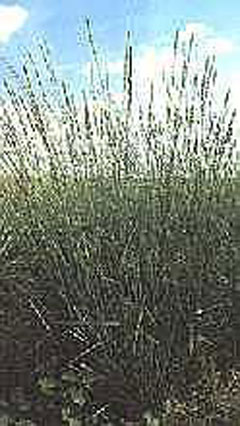 |
|
http://ecocrop.fao.org/ecocrop/srv/en/cropView?id=2922 |
 |
|
Translate this page:
Summary
Physical Characteristics

 Agropyron elongatum is an evergreen Perennial growing to 1.8 m (6ft).
Agropyron elongatum is an evergreen Perennial growing to 1.8 m (6ft).
See above for USDA hardiness. It is hardy to UK zone 6 and is not frost tender. It is in leaf all year. The species is hermaphrodite (has both male and female organs) and is pollinated by Wind.
Suitable for: light (sandy), medium (loamy) and heavy (clay) soils. Suitable pH: mildly acid, neutral and basic (mildly alkaline) soils and can grow in very alkaline and saline soils.
It cannot grow in the shade. It prefers dry or moist soil.
UK Hardiness Map
US Hardiness Map
Synonyms
Plant Habitats
Cultivated Beds;
Edible Uses
References More on Edible Uses
Medicinal Uses
Plants For A Future can not take any responsibility for any adverse effects from the use of plants. Always seek advice from a professional before using a plant medicinally.
None known
References More on Medicinal Uses
The Bookshop: Edible Plant Books
Our Latest books on Perennial Plants For Food Forests and Permaculture Gardens in paperback or digital formats.

Edible Tropical Plants
Food Forest Plants for Hotter Conditions: 250+ Plants For Tropical Food Forests & Permaculture Gardens.
More

Edible Temperate Plants
Plants for Your Food Forest: 500 Plants for Temperate Food Forests & Permaculture Gardens.
More

More Books
PFAF have eight books available in paperback and digital formats. Browse the shop for more information.
Shop Now
Other Uses
Biomass Soil reclamation
The plant establishes well on wet alkaline soils and is extensively used in reclaiming such areas. It has been reported to be promising even in the arid zone of South Australia where rainfall is 12.5 - 20 cm annually. The plant has also been recommended for reclaiming saline soils and it has also been shown how the species can be used in reclaiming red mud bauxite residues[269]. According to the phytomass files (Duke, 1981b), annual productivity ranges from 2 to 15 MT/ha, which phytomass could be converted to alcohol or methane[269].
Special Uses
References More on Other Uses
Cultivation details
A very tolerant plant, able to grow in a wide range of conditions. It succeeds in soils with a pH of 5.3 - 9.0, and thrives in areas subject to inundation by saline water, such as seashores and saline meadows as well as on alkaline soils[269]. The plant grows best in full sun but tolerates some shade. Tall wheatgrass is reported to tolerate an annual precipitation in the range of 30 to 210cm and average temperatures ranging between 5° to 19°C[269]. Not all forms of the plant are frost-tolerant, but some forms will succeed even in Northern Canada[269]. Coming from the Mediterranean region with its dry summers, this is a cool-season grass that grows mainly from the autumn round to the spring and then can become dormant in the summer[269].
References Carbon Farming Information and Carbon Sequestration Information
Temperature Converter
Type a value in the Celsius field to convert the value to Fahrenheit:
Fahrenheit:
The PFAF Bookshop
Plants For A Future have a number of books available in paperback and digital form. Book titles include Edible Plants, Edible Perennials, Edible Trees,Edible Shrubs, Woodland Gardening, and Temperate Food Forest Plants. Our new book is Food Forest Plants For Hotter Conditions (Tropical and Sub-Tropical).
Shop Now
Plant Propagation
Seed - surface sow, or only just cover the seed, in a greenhouse in early autumn. Germination should take place within a few days. When large enough to handle, prick out the seedlings into individual pots and plant out in the following autumn or spring. If you are sowing a large area, then the seed can be sown in situ, preferably in early autumn, though in areas experiencing heavy frosts in the winter it would be best to sow the seed in the spring. A seed rate of 9 - 13 kg per hectare is recommended[269].
Other Names
If available other names are mentioned here
Native Range
TEMPERATE ASIA: Cyprus, Israel, Syria, Turkey (west), Russian Federation-Ciscaucasia (Ciscaucasia), Armenia, Azerbaijan, Georgia, Russian Federation (Dagestan) EUROPE: Russian Federation-European part (European part (south)), Ukraine (incl. Krym), Albania, Bulgaria, Greece, Croatia, Italy (incl. Sardinia, Sicily), Romania, Slovenia, Spain (incl. Baleares), France (s. & Corsica), Portugal AFRICA: Algeria (north), Egypt, Morocco, Tunisia
Weed Potential
Right plant wrong place. We are currently updating this section.
Please note that a plant may be invasive in one area but may not in your area so it's worth checking.
Conservation Status
IUCN Red List of Threatened Plants Status :

Growth: S = slow M = medium F = fast. Soil: L = light (sandy) M = medium H = heavy (clay). pH: A = acid N = neutral B = basic (alkaline). Shade: F = full shade S = semi-shade N = no shade. Moisture: D = dry M = Moist We = wet Wa = water.
Now available:
Food Forest Plants for Mediterranean Conditions
350+ Perennial Plants For Mediterranean and Drier Food Forests and Permaculture Gardens.
[Paperback and eBook]
This is the third in Plants For A Future's series of plant guides for food forests tailored to
specific climate zones. Following volumes on temperate and tropical ecosystems, this book focuses
on species suited to Mediterranean conditions—regions with hot, dry summers and cool, wet winters,
often facing the added challenge of climate change.
Read More
Expert comment
Author
(Host.)Beauv.
Botanical References
269
Links / References
For a list of references used on this page please go here
Readers comment
© 2010, Plants For A Future. Plants For A Future is a charitable company limited by guarantee, registered in England and Wales. Charity No. 1057719, Company No. 3204567.